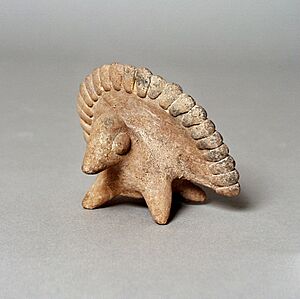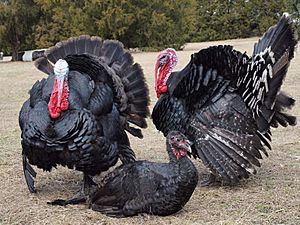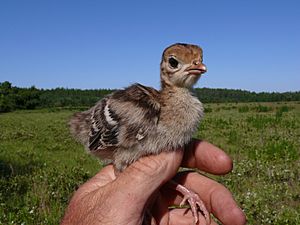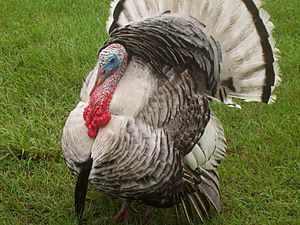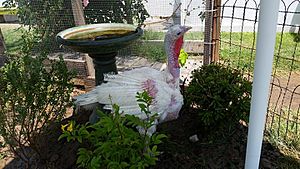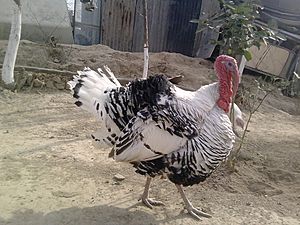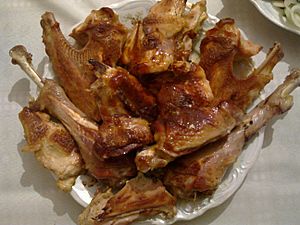Domestic turkey facts for kids
Quick facts for kids Domestic turkey |
|
|---|---|
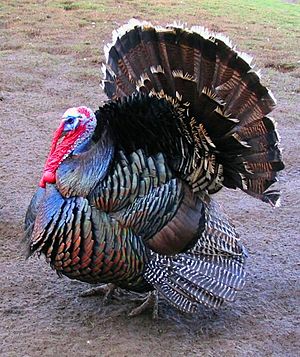 |
|
| A Broad Breasted Bronze male (tom) displaying | |
| Conservation status | |
| Scientific classification |
|
| Kingdom: | Animalia |
| Phylum: | Chordata |
| Class: | Aves |
| Order: | Galliformes |
| Family: | Phasianidae |
| Genus: | Meleagris |
| Species: | |
| Subspecies: |
M. g. domesticus
|
| Trinomial name | |
| Meleagris gallopavo domesticus (Linnaeus, 1758)
|
|
The domestic turkey (Meleagris gallopavo domesticus) is a large bird that people raise for food. It's one of two types of birds in the Meleagris family. Domestic turkeys are the same species as the wild turkey. People first started raising turkeys in central Mesoamerica (which is now Mexico and Central America) over 2,000 years ago. Some new studies suggest they might have also been tamed in the southwestern United States around 200 BC to AD 500.
However, most of the turkeys we see today come from the turkeys first raised in central Mexico. Spanish explorers brought these turkeys to Europe in the 1500s. Domestic turkeys are very popular for their meat. They are raised all over the world, especially because modern farming makes them affordable.
Female domestic turkeys are called hens. Baby turkeys are called poults or turkeylings. In the United States, male turkeys are called toms. In the United Kingdom and Ireland, males are called stags. Most domestic turkeys have white feathers. This is because their small, stiff feathers (called pin feathers) are less noticeable when the bird is prepared for cooking. Some brown or bronze-feathered turkeys are also raised.
Turkeys have some unique features on their heads. The fleshy part on top of their beak is called a snood. The fleshy part hanging under their beak is called a wattle. The English name "turkey" comes from a mistake. People thought the bird came from the country of Turkey, but it actually came from the Americas. The scientific name gallopāvō means "chicken peacock" in Latin.
Contents
History of Domestic Turkeys
Today's domestic turkeys come from a type of wild turkey found in parts of Mexico. Ancient people in Mesoamerica were the first to tame these birds. They used turkeys for their meat and eggs, which were important sources of protein. They also used turkey feathers for decorations. The Aztecs even linked turkeys to their trickster god, Tezcatlipoca. This might have been because of the turkey's funny behavior.
Spanish explorers brought domestic turkeys to Europe. Over time, many different types of turkeys were developed in Europe. Examples include the Spanish Black and the Royal Palm. In the early 1900s, people made big improvements in how they bred turkeys. This led to new types like the Beltsville Small White.
An English sailor named William Strickland is often given credit for bringing turkeys to England in the 1500s. His family's coat of arms even shows a turkey! By 1573, turkeys were already being eaten for Christmas in England. The domestic turkey was sent from England to Jamestown, Virginia in America in 1608.
Before the late 1800s, turkey was a special treat in the UK. Goose or beef were more common for Christmas dinner. In Charles Dickens' famous story A Christmas Carol (1843), Bob Cratchit had a goose before Scrooge bought him a turkey.
Turkey farming in the UK was big in East Anglia. Farmers would even walk their flocks of turkeys, sometimes with special shoes, all the way to markets in London. This started in the 1600s.
After the 1940s, new farming methods made turkeys much cheaper. This made them more affordable for everyone. Freezing and better ways to control diseases also helped increase turkey production. Today, fresh turkey is also easy to find and not too expensive.
Turkey Behavior
Young domestic turkeys can fly short distances. They also like to perch and roost, which means resting on a high spot. As they get older, they fly less, but adult turkeys still enjoy climbing onto things like hay bales. Young turkeys sometimes run around playfully, just for fun!
Turkeys are very social birds. They get upset if they are left alone. If one turkey does something, like flapping its wings, other turkeys often start doing it too. Adult turkeys can tell strangers apart. If a new turkey is put into a group, the others will likely attack it. This can sometimes be very serious.
Turkeys make many different sounds. You can tell if they are getting aggressive by their high-pitched trills. If they get into a fight, they might jump at each other. They use their sharp talons and try to peck or grab the other turkey's head. Fights happen more often as turkeys get older.
Male turkeys spend a lot of time showing off, especially when they are ready to mate. They fan out their tail feathers and droop their wings. All their body feathers stand up, including the "beard" on their chest. The skin on their head and neck turns bright blue and red. Their snood gets longer. They also make a special "gobbling" sound. They walk slowly, with their neck arched back and chest pushed forward.
Size and Weight
| Animal | Average mass kg (lb) |
Maximum mass kg (lb) |
Average total length cm (ft) |
|---|---|---|---|
| Domestic turkey | 13.5 (29.8) | 39 (86) | 100 - 124.9 (3.3 – 4.1) |
The domestic turkey is one of the largest living birds. It can weigh up to 39 kilograms (86 pounds)!
Turkey Breeds
- The Broad Breasted White is the most common turkey raised on large farms. It's the type most people eat.
- The Broad Breasted Bronze is another type raised for meat.
- The Standard Bronze looks similar to the Broad Breasted Bronze but can breed naturally.
- The Bourbon Red is a smaller breed with reddish feathers and white marks.
- Slate or Blue Slate turkeys are rare and have gray-blue feathers.
- The Black turkey (also called "Spanish Black" or "Norfolk Black") has very dark, shiny feathers.
- The Narragansett Turkey is a popular old breed named after a bay in New England.
- The Chocolate is a rare old breed with light brown feathers.
- The Beltsville Small White is a small heritage breed developed in the 1930s.
- The Midget White is an even smaller heritage breed.
Commercial Production
In commercial turkey farming, special farms raise turkeys to produce eggs. These eggs are sent to hatcheries. After 28 days of incubation, the baby turkeys hatch. They are then sorted by sex and sent to farms where they will grow. Male and female turkeys are usually raised separately because they grow at different speeds.
In the UK, young chicks are often kept in small round pens for the first week. This helps them find food and water easily. They might have constant light for the first two days to encourage them to eat. The temperature is kept warm at first and then slowly lowered. Food is spread out on paper sheets to make it easy for them to find. After a few days, the pens are removed, and the birds can access the whole shed. These sheds can be very large and hold thousands of birds.
Most turkeys are raised indoors in special buildings. Some buildings have slatted walls for air, while others have solid walls and no windows. This allows farmers to control the lighting to help the turkeys grow. The floor is usually covered with wood shavings. The temperature for adult turkeys is kept between 18 and 21 degrees Celsius (64-70 degrees Fahrenheit). Turkeys can get stressed by too much heat.
Commercial turkeys are given different lighting schedules to encourage them to eat and grow faster. The light is usually dim to prevent them from pecking each other's feathers. Their food usually includes corn and soybean meal, with added vitamins and minerals. This food is adjusted for their age and needs. Female turkeys are usually ready for slaughter at about 14–16 weeks old. Males are ready at about 18–20 weeks old. At this age, they can weigh over 20 kilograms (44 pounds). A wild male turkey usually weighs around 10.8 kilograms (24 pounds).
Breeding and Companies
The most common turkey for commercial farming is the Broad-Breasted White. These turkeys have been specially bred to be very large and have a lot of meat. Adult male turkeys (toms) are often too big to breed naturally without hurting the hens. So, their semen is collected, and the hens are artificially inseminated. This means fewer male turkeys are needed. The meat from breeding turkeys is usually too tough for roasting. It is mostly used for processed meats like deli slices.
Waste Products
The poultry industry produces a lot of feathers every year. Most of these feathers are ground up and used as a protein source for animal feed. Researchers have found ways to remove the stiff part of the feather from the soft fibers. These fibers can be used to make textiles. For example, turkey feather fibers have been mixed with nylon to make yarn for knitting. Fabrics made with turkey feather fibers can be good for insulation, meaning they help keep things warm.
Turkeys as Food
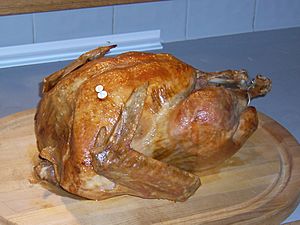
| Nutritional value per 100 g (3.5 oz) | |
|---|---|
| Energy | 465 kJ (111 kcal) |
|
0 g
|
|
| Sugars | 0 g |
| Dietary fiber | 0 g |
|
0.7 g
|
|
|
Protein
|
24.6 g
|
| Vitamins | Quantity
%DV†
|
| Thiamine (B1) |
0%
0 mg |
| Riboflavin (B2) |
8%
0.1 mg |
| Niacin (B3) |
41%
6.6 mg |
| Pantothenic acid (B5) |
14%
0.7 mg |
| Vitamin B6 |
46%
0.6 mg |
| Folate (B9) |
2%
8 μg |
| Vitamin C |
0%
0 mg |
| Minerals | Quantity
%DV†
|
| Calcium |
1%
10 mg |
| Iron |
9%
1.2 mg |
| Magnesium |
8%
28 mg |
| Phosphorus |
29%
206 mg |
| Potassium |
10%
293 mg |
| Sodium |
3%
49 mg |
| Zinc |
13%
1.2 mg |
| †Percentages estimated using US recommendations for adults. Source: USDA Nutrient Database |
|
About 620 million turkeys are used for meat each year around the world. Turkeys are a traditional main dish for Christmas dinners in many English-speaking countries. They have been eaten in England for Christmas since the 1500s. Turkeys are also a very important part of Thanksgiving meals in the United States and Canada. While turkeys used to be mostly for special holidays, they are now eaten all year round.
Turkeys are sold in many forms. You can buy them sliced, ground, or as a whole bird with the head, feet, and feathers removed. Frozen whole turkeys are still popular. Sliced turkey is often used for sandwiches or cold cuts. Ground turkey is a popular healthy substitute for ground beef.
Cooked turkey can sometimes be less moist than other poultry like chicken or duck. This is especially true if it's not prepared carefully. The breast meat of a turkey can be breaded and cooked, similar to chicken nuggets.
Wild turkeys taste very different from farm-raised turkeys. Almost all wild turkey meat is "dark meat," even the breast. It has a stronger flavor. The taste can also change depending on what the wild turkey has eaten. If it eats more insects, it might have a gamier flavor. If it eats mostly grass and grain, it will taste milder. Older types of heritage turkeys also have different flavors.
Unlike chicken or duck eggs, turkey eggs are not usually sold for food. This is because there is a high demand for whole turkeys. Also, turkeys lay fewer eggs than other birds. A single turkey egg can be quite expensive.
White turkey meat is often thought to be healthier than dark meat because it has less fat. However, the difference in nutrition is actually small. Some people think turkey makes them sleepy. But holiday meals are usually large, with lots of carbohydrates and fats. These things, along with a relaxed atmosphere, are more likely to make you sleepy than the turkey itself.
Cooking Turkeys
Both fresh and frozen turkeys are used for cooking. Fresh turkeys are usually preferred, but they cost more. During holiday seasons, it can be hard to buy a fresh turkey without ordering it ahead of time. If you buy a frozen turkey, it can take several days to thaw properly because of its large size.
Turkeys are usually baked or roasted in an oven for several hours. Cooks often prepare the rest of the meal while the turkey bakes. Sometimes, a turkey is soaked in a salty water mixture called a brine before roasting. This helps to make it more flavorful and moist. The dark meat of a turkey needs to be cooked to a higher temperature than the white meat. Brining helps to cook the dark meat fully without drying out the white breast meat. Turkeys are sometimes decorated with special paper frills before serving.
In some areas, especially the American South, turkeys are also deep fried in hot oil. This usually takes about 30 to 45 minutes. Deep frying turkeys has become popular, but it can be dangerous if not done safely. This is because it uses large amounts of very hot oil.
Turkey Litter for Fuel
Turkey litter is a mix of turkey droppings and bedding material, like wood chips. It is often used as fertilizer for plants. But it can also be used as a fuel source in power plants that make electricity. For example, a power plant in Minnesota uses 500,000 tons of turkey litter each year to create 55 megawatts of power. This plant started working in 2007.
See also
 In Spanish: Pavo doméstico para niños
In Spanish: Pavo doméstico para niños


